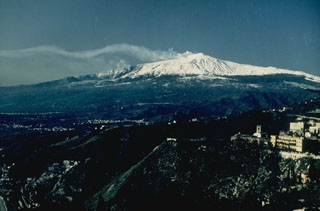Report on Etna (Italy) — 23 April-29 April 2025
Smithsonian Institution / US Geological Survey
Weekly Volcanic Activity Report, 23 April-29 April 2025
Managing Editor: Sally Sennert.
Please cite this report as:
Global Volcanism Program, 2025. Report on Etna (Italy) (Sennert, S, ed.). Weekly Volcanic Activity Report, 23 April-29 April 2025. Smithsonian Institution and US Geological Survey.
Etna
Italy
37.748°N, 14.999°E; summit elev. 3357 m
All times are local (unless otherwise noted)
The Sezione di Catania - Osservatorio Etneo (INGV) reported continuing activity at Etna during 21-27 April, characterized by Strombolian activity with lava overflows at SE Crater and gas emissions at Bocca Nuova Crater, NE Crater, and Voragine. Strombolian activity at SE Crater began at 2000 on 22 April that involved at least three vents and was followed by lava overflowing onto the SE flank. At 2145 a second lava flow descended the S flank. The activity ceased at around 0300 on 23 April. Satellite data from 27 April was used to map the flows. The SE-flank flow covered an area of about 34,000 square meters and was about 700 m long, reaching 2,940 m elevation. The S-flank flow covered about 6,000 square meters and was about 200 m long, reaching 3,170 m elevation.
Geological Summary. Mount Etna, towering above Catania on the island of Sicily, has one of the world's longest documented records of volcanism, dating back to 1500 BCE. Historical lava flows of basaltic composition cover much of the surface of this massive volcano, whose edifice is the highest and most voluminous in Italy. The Mongibello stratovolcano, truncated by several small calderas, was constructed during the late Pleistocene and Holocene over an older shield volcano. The most prominent morphological feature of Etna is the Valle del Bove, a 5 x 10 km caldera open to the east. Two styles of eruptive activity typically occur, sometimes simultaneously. Persistent explosive eruptions, sometimes with minor lava emissions, take place from one or more summit craters. Flank vents, typically with higher effusion rates, are less frequently active and originate from fissures that open progressively downward from near the summit (usually accompanied by Strombolian eruptions at the upper end). Cinder cones are commonly constructed over the vents of lower-flank lava flows. Lava flows extend to the foot of the volcano on all sides and have reached the sea over a broad area on the SE flank.

